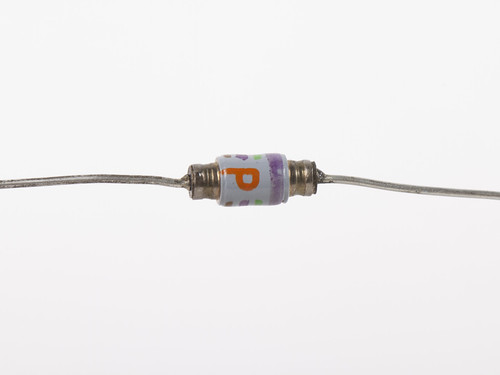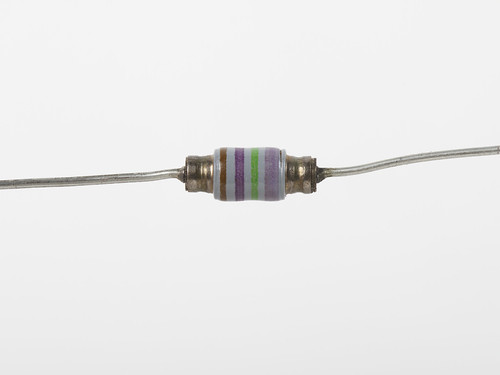
While picking out interesting vintage diodes at the electronics flea market, we came across a couple of components— possibly also diodes because of where we found them —of types that we have never seen before. And we can’t resist a good mystery.
First, there’s this little two legged can, marked with 650, a black dot, and CO on one side. The other side (as you can see in the photo above this one), is marked T 1 and has black and red dots.
Secondly, a couple of things that look kind of like resistors:

They are very small, only about the size of 1/4 W resistors. They are marked with a red capitol letter “P” and a set of four colored stripes. The “P” marking interrupts the three narrower bands in both cases.

Here’s a good look at the color bands: brown, violet, green, and then a broad yellow. (We could be reading this wrong; is the broad stripe supposed to be read first?)

This one has brown, violet, green, and then broad violet.
So, what are they? We don’t actually know, but if you do, or if you have a good guess, we’d love to hear it!





Yeah, I’d vote for “oddly shaped resistor” for those last two. So that would be 1.7 MOhm, with a tolerance of 5% and 0.1% respectively. It’s an odd value, but then they’re odd looking as well.The red (orange?) P could be a temperature coefficient (15 ppm/K).
Easy enough to check with the multimeter whether they’re in the right range.
I would vote for a Crystal for the first one an inductors/coils for the others.
Best regards
Michael
I would agree with you, but I have noticed a bump on the top of the first component above one pin, possibly indicating a polarity or a forward direction. Crystals do not have these.
Ta
Could be a 1N457 diode and 1N757 zener diode (9.1V)
See http://www.csgnetwork.com/diodecolorstable.html
Shouldn’t the obvious answer be “add them into a simple circuit with known behavior, measure the new behavior with a range of V and a range of i, then match measured behavior to known component types”? Why guess when you can know empirically?
the colour banded components do look like they might be inductors…
any measurements yet?
the huntron http://www.huntron.com/ is a wonderful tool for finding out unknown components and matching them with others of similar values…
dan
Are you sure that’s not “TI” on the canned two-lead devices? Texas Instruments was a very early entrant in semiconductors.
The stripe-coded ones are almost certainly diodes; if they’re still good, a moden DVM will confim it in a trice, and the forward voltage drop will help you determine of they are germanium or silicon types.
I agree with DTK and to be honest I’m a bit gobsmacked (or flabbergasted?) that EMS didn’t take this road in the first place.
But then I saw: the S is for SCIENCE, which means they first have to generate proper hypotheses before they can go at it empirically…
RIGHT?
So EMS, show your viewers what it means to generate hypotheses and them test them empirically…
If someone happens to know what they are, and can point us at the datasheets, that’s awesome; we’ll be plenty satisfied.
If not, we’ll have to figure out what they are from scratch, and that’s a separate process.
i think the can is a crystal ceramic filter . they mark them with black dots and the ‘co’ marking is in reference to the q factor of the filter i think maby the ‘c’ we see is a partial q. as for the others , im gonna say their high end inductors .